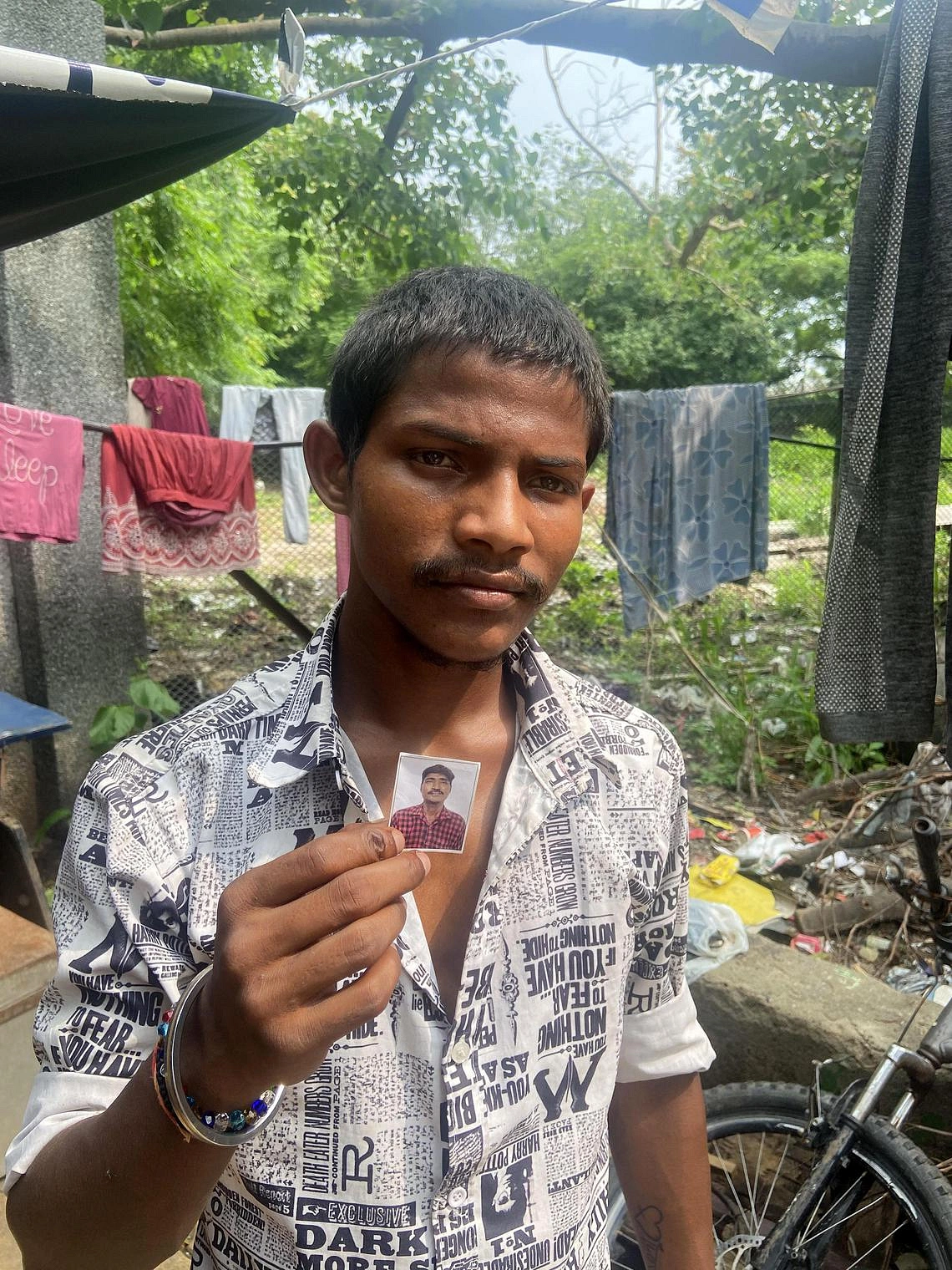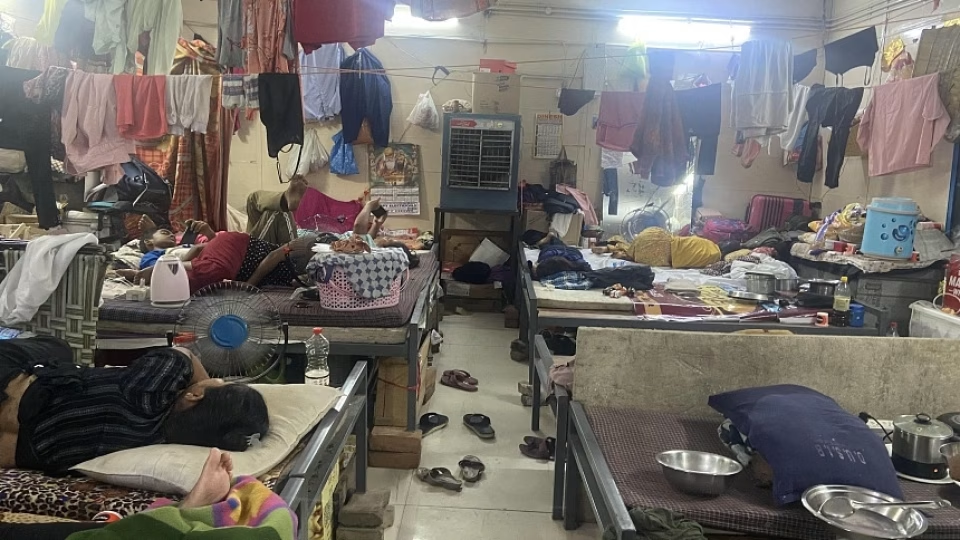August 26, 2024
NEW DELHI – The memories of the unprecedented heatwave in India in 2024 will never fade for 19-year-old Aakash Kumar, whose father died in the summer.
Sitting under dark clouds as the monsoon rains brought cooling relief after the hottest May and June on record, Mr Kumar said his father Abhinash woke up on June 19 complaining about the heat.
The 55-year-old felt uneasy and hesitant about going to work cleaning public toilets in the city.
He was right to be concerned. On June 18 and 19, night-time temperatures hit a five-decade high for June at 35.2 deg C. Day temperatures hovered at around 45 deg C.
But the fear of losing a day’s salary as a cleaner earning 7,000 rupees (S$110) a month drove him to go to work 2km away.
Mr Kumar said: “I went to meet him at work carrying lunch, and he kept telling me he was feeling uneasy and felt he couldn’t breathe. He was sweating.
“He ate a little dal and rice and drank some water, but then he started getting worse. He told me he felt like he was going to die.”
His father became increasingly disoriented and died on the way to hospital.
“I don’t go out anywhere now. Everything reminds me of my father,” said Mr Kumar, whose mother left when he was 12.
His aunt, Ms Vinita Singh, who was moved with the two of them and her own three children to a homeless shelter in 2023, said May and June had been unbearable.
They sheltered under blue tarpaulin stretched over makeshift wooden structures. Every night, the family of six squeezed onto a narrow bench and a charpoy, a traditional Indian bed made of rope.
“We would sleep in wet clothes at night to keep cool because we had no fans. I used a hand fan. It was unbearable,” said Ms Singh, who would bathe her two younger children, aged seven and nine, at least twice in the night.
“What choice do we have? We have to bear the heat,” she added.

Mr Aakash Kumar, 19, with a picture of his father Abhinash, 55, who died in June in India’s capital city of New Delhi. PHOTO: THE STRAITS TIMES
May and June 2024 were the hottest in seven decades in Delhi and other parts of India.
The poorest and most vulnerable segments of society were the most affected by the heat. They included the homeless and migrant workers, particularly those working in construction and the gig economy, or as autorickshaw drivers.
In Delhi in 2024, the temperature peaked at 49.1 deg C on May 29. This came after the hottest December and February since 1901. And heatwaves are lasting longer, said scientists and activists.
Globally, temperatures are going up as a result of global warming, mainly because of the burning of fossil fuels and deforestation. Steps taken to reduce greenhouse gases are not expected to have an immediate impact, with countries’ plans to reduce their dependence on fossil fuels and increase the share of renewable energy focused on the long term.
In keeping with global warming trends, the average temperature went up by an average of 0.7 deg C between 1901 and 2018 in India, according to a 2020 report assessing the impact of climate change by the Ministry of Earth Sciences.
According to the United Nations’ World Meteorological Organisation, the global average temperature for the July 2023 to June 2024 period reached 1.64 deg C above the 1850 to 1900 pre-industrial average.
July 2024 was the hottest July on record, making it the 14th straight record-breaking month, the US National Oceanic and Atmospheric Administration said.

The inside of a homeless shelter in India’s capital city of New Delhi. PHOTO: THE STRAITS TIMES
Cruel summer
According to government figures, 100 people across India died as a result of the heatwave in May and June and 40,000 suffered sunstroke. But activists say many deaths remained unaccounted for.
Collecting data from Delhi morgues, hospitals and crematoriums, the Centre for Holistic Development said 582 homeless people, including the older Mr Kumar, died in the heatwave in June. Last year, 277 people died in June, it added.
Citing its own statistics, the non-profit’s founder, Mr Sunil Kumar Aledia, said Delhi’s heatwave action plan, prepared by the Delhi Disaster Management Authority, which came into force in 2024, held little meaning for those who did not have proper shelter such as the homeless or had little choice but to work outdoors.
According to the heatwave action plan, workplaces have to provide clean drinking water, fans or water coolers, and proper ventilation.
The authorities must warn the public and highlight the importance of staying hydrated through public messages.
Before summer begins, they have to set up shelters and water stations in areas with a vulnerable population. They must offer free health checks for workers, as well as post more staff in hospitals, deploy medical response teams and have water at bus stops.
As the heat went up, Delhi’s water and electricity consumption also increased as the use of air-conditioners and water coolers went up, resulting in an electricity and water shortfall.
Delhi, which gets its water from groundwater sources and rivers, had a supply shortage of 321 million gallons per day (mgd) daily during the heatwave. The city needs 1,290 mgd per day.
The death of a labourer on May 30 due to the heatwave prompted Delhi’s Lieutenant-Governor to additionally order water to be sprinkled on scorching roads and ask for change in the work hours for construction workers.
Activists said not enough shelters or water stations were set up.
Another directive asking workplaces to remain shut and give their workers a paid break when the heat peaked during the day was rarely implemented, said Mr Aledia.
“Those who are vulnerable are affected the most. They don’t have a house and even if they do, the houses are not properly ventilated.”
He said: “The government has to come up with additional measures and do more for the vulnerable.”
Activists noted that availability of cold drinking water remained a challenge this summer.
The shortage of water coupled with a fear of its contamination put paid to traditional practices, such as keeping claypots on street corners filled with water by good Samaritans for public use, or cold water in reusable drinking glasses, sold for two rupees, in water trolleys at bus stops and street corners.
Delivery people or other gig workers also depend on the goodwill of people to provide them with cold water.
But this summer, even those with a roof over their head found the heat difficult to bear.
At Shahpur Jat village in South Delhi, where many designers have set up shops selling heavily embroidered bridal wear, Mr Sheikh Samiullah, 40, wove colourful threads through blue cloth.
Sweat poured down his forehead as he worked in a windowless room with three fans going on the second floor of a dilapidated building.

Embroiderer Sheikh Samiullah with his toddler at this work bench in capital city New Delhi. PHOTO: THE STRAITS TIMES
May and June were intolerable, he said. He faced extreme heat, water shortages and long electricity cuts. The city has multiple water “ATMs” dispensing for free or a nominal fee, but many were not working.
“For two months, we did nothing as we could not work,” said the embroiderer, who had to take out a loan for the rent and other living expenses.
Next May and June, he said, he will go back to his village more than 1,500km away in West Bengal.
His wife Ruma, who was sticking sparkly sequins on beige cloth, had done just that with their two-year-old, returning to Delhi only at the beginning of August. She said she did not feel the heat as much in the village, where they live in mud huts, surrounded by greenery.
“I will also go to the village. I will still have to pay rent but at least I won’t face so many problems,” said Mr Samiullah.
Hot cities
The country’s urban centres are facing the brunt of climate change. Cities such as Delhi suffer from the urban heat island effect, which results in built-up areas being warmer than the surrounding rural areas.
With the roads and buildings retaining the sun’s heat, it is estimated that urban centres are 2 deg C hotter than rural areas.
And night-time temperatures are also climbing.
“What has been worrisome is that night-time temperatures were unusually high (this summer) and did not permit the body to adjust from the higher temperature during the day. It created much more of a health hazard,” said Professor K. Srinath Reddy of the Public Health Foundation of India.
He added that policymakers and city planners will need to make urban centres more resilient to rising temperatures.
“You have to build cities that are much more friendly to people in terms of protection from the heat. There should be more shelters, more water stations, planting of trees that give natural shade and more reflective surfaces on buildings,” he said.
The authorities said multiple measures were taken, including asking the police to help anyone in need, and ensuring hospitals were well equipped to take care of heatstroke admissions. In June, Delhi government minister Saurabh Bharadwaj asked residents to plant trees.
Still, Mr Rajesh Kumar, executive director of the Society for Promotion of Youth and Masses, which runs homeless shelters in the city, said awareness could be better about the measures one can take to help oneself or others during a heatwave.
“In winter, there is a lot of awareness (about the cold) even though deaths also take place. Civil society and those who do charity are prepared. They come out on winter days to provide blankets and donate woollen clothes,” he said.
“But the heat is not considered as bad because Delhi is a city with high temperatures. It’s fine if you can find some shade. And dehydration is not understood by the larger population. It will take some time for people to understand.”


